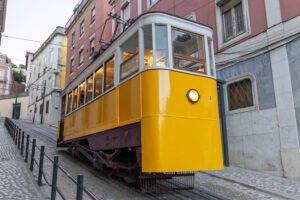A cable car accident in Lisbon, Portugal, on September 3, 2025, killed 16 people and injured at least 21 others when the historic Elevador da Gloria funicular derailed and crashed into a building during evening rush hour around 6:01 p.m. local time.
The victims included five Portuguese nationals, three Britons, two South Koreans, two Canadians, one French woman, one Swiss national, one American, and one Ukrainian, according to Portuguese national police. Among those killed was Andre Jorge Goncalves Marques, a brake guard who worked on the funicular railway.
The American victim was identified as Heather Hall, a mother of two and college instructor from South Carolina who was visiting Portugal to speak at a conference. Hall worked as an instructor specializing in literacy and special education at the College of Charleston. Her family indicated she passed away doing what she did best, living life fully and with a heart wide open to the world.
Among the Canadian victims were Aziz Benharref, 42, and his wife Hind Iguernane, though Iguernane survived with injuries including a fractured hip and shoulder. Benharref had switched seats with his wife moments before the crash for her comfort. Iguernane reported she remained unconscious for days before learning of her husband’s death, with hospital staff initially telling her they were still searching for him.
Also killed were Andre Bergeron of Quebec and his wife Blandine Daux, a permanent resident of Canada and French citizen, who were on their final day of vacation in Portugal. Four employees of the Santa Casa da Misericordia charity were among the Portuguese victims, believed to have been commuting from work.
The injured included people from Portugal, Spain, Israel, Brazil, Italy, France, and Germany. Among the survivors was a three-year-old German child whose father died in the crash and whose mother was injured. Six people remained in intensive care, with three sustaining minor wounds.
Portuguese investigators determined that a cable connecting the two funicular cars snapped at its attachment point, causing the descending carriage to careen down the steep hill at approximately 37 mph before derailing and crashing into a building. The brakeman attempted to apply emergency brakes but failed to prevent the derailment, according to preliminary findings released by the Office for the Prevention and Investigation of Accidents in Civil Aviation and Rail.
Prime Minister Luis Montenegro described the incident as “one of the biggest tragedies in our recent history” and promised a swift investigation. Portugal observed a national day of mourning on September 4, with President Marcelo Rebelo de Sousa and other officials attending a memorial service near the crash site.
The 140-year-old Elevador da Gloria funicular, inaugurated in 1885, operates with two cars connected by steel cables that move in tandem up and down the steep hill between Restauradores Square and the Bairro Alto neighborhood. The system carries approximately three million people annually, serving both tourists and local residents navigating the city’s steep terrain.
Carris, the municipal company operating the funicular, maintained that all maintenance protocols had been carried out, including daily inspections and monthly service programs. However, union leader Manuel Leal indicated that workers had previously complained about cable tension problems that made braking difficult, though he noted it was too early to determine if this contributed to the crash.
Witnesses described the scene as chaotic, with the streetcar appearing out of control as it careened down the hill. One observer told local media the car hit the building with brutal force and fell apart like a cardboard box. Emergency responders pulled all victims from the wreckage within two hours of the initial alert.
Following the accident, Lisbon City Council suspended operations of the three other funicular railways in the city – Bica, Lavra, and Graca – pending safety inspections.
Teams of pathologists from the National Forensics Institute, reinforced by colleagues from three other Portuguese cities, worked through the night conducting autopsies. Portuguese national police indicated they will issue a comprehensive report on any potential criminal aspects within 45 days, while transport officials released preliminary technical findings within days of the incident.
The crash marked the worst disaster in recent Lisbon history, affecting visitors from across the globe who had come to experience one of the city’s most iconic tourist attractions. Portugal welcomed an estimated 29 million foreign visitors in 2024, many of whom used the historic funicular system to navigate the capital’s hilly landscape.

